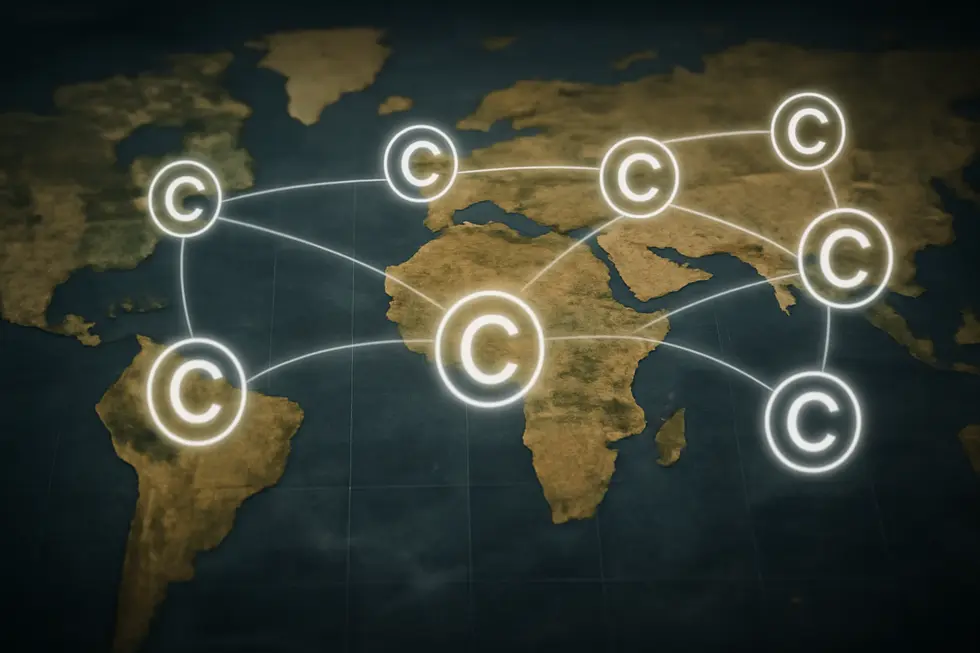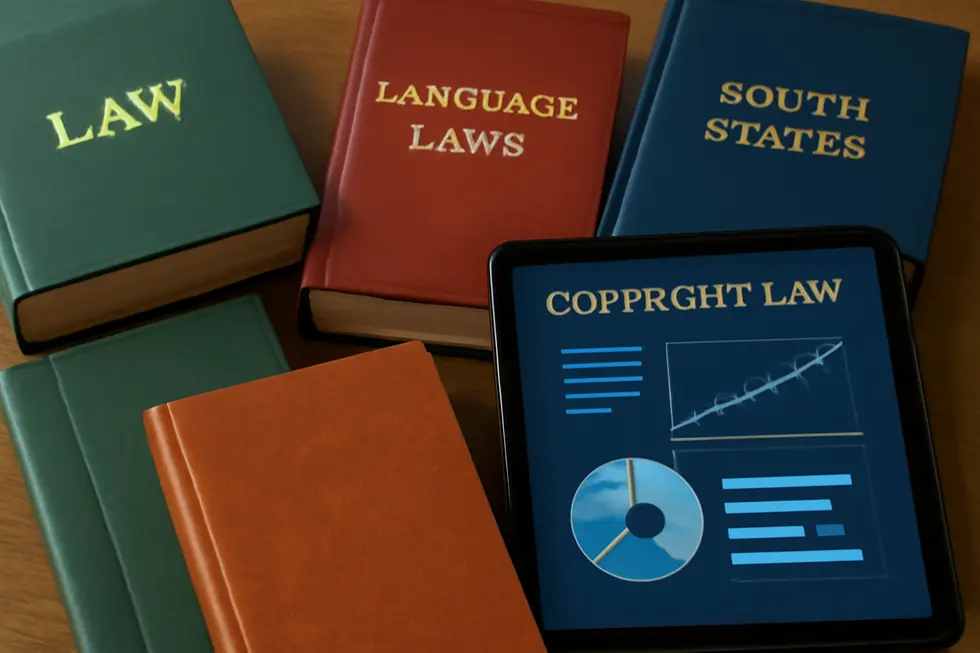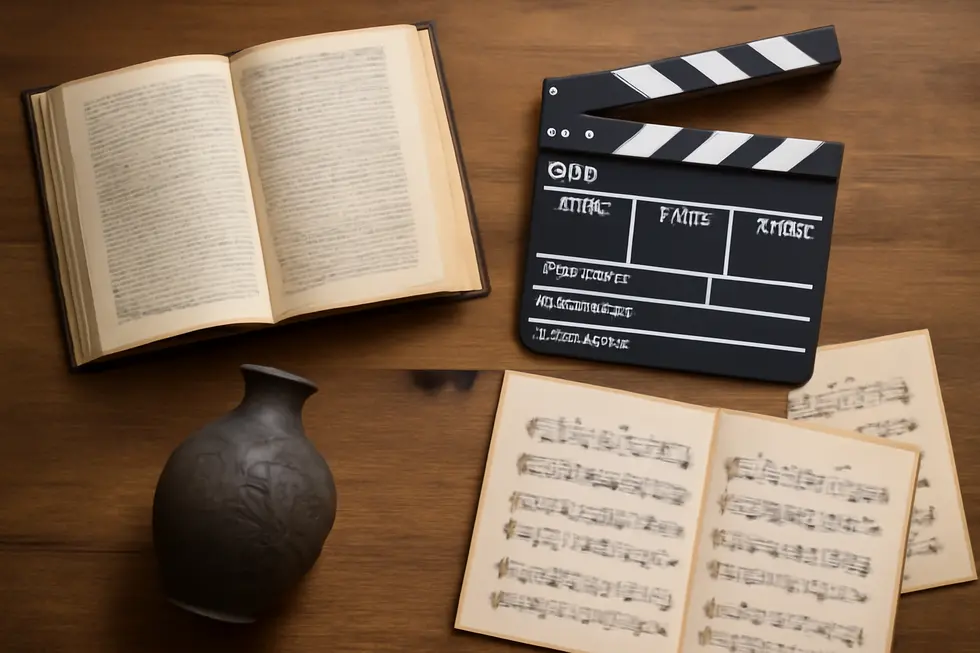Introduction
For business owners, comprehending the copyright term is critical to managing and safeguarding intellectual property effectively. The copyright term defines how long creators hold exclusive rights over their original works, influencing licensing, use, and strategic planning across markets. This article explores the international agreements that set baseline protections, examines country-specific variations impacting global commerce, details how different types of works are governed, clarifies legal rights during the copyright duration, and looks at what happens when works enter the public domain. Together, these components provide essential knowledge for making informed decisions on utilizing and protecting creative assets in business.
Tables of Contents
Chapter 1: International Standards and the Copyright Term
- Global Copyright Benchmarks: How the Berne Convention and TRIPS Agreement Shape Protection Duration
- Navigating National Variations: How Countries Extend and Adapt Copyright Terms Beyond International Norms
- Navigating Copyright Duration Differences: Geopolitical Stakes and Economic Consequences
Chapter 2: Country-Specific Variations in Copyright Term Duration
- Legal and Technological Drivers Behind Divergent Copyright Terms Worldwide
- Global Economic and Geopolitical Dynamics Shaped by Diverse Copyright Durations
- How National Laws Shape Cultural Access and Creative Incentives Through Varying Copyright Terms
Chapter 3: Copyright Term for Different Types of Works
- Understanding Duration Variations in Copyright for Literary, Artistic, Dramatic, and Musical Creations
- Navigating the Nuances: Copyright Duration for Sound Recordings, Films, and Broadcasts Across Jurisdictions
- Navigating Legal Nuances and Exceptions Shaping Copyright Duration by Work Type
Chapter 4: Legal Implications and Rights During the Copyright Term
- The Scope of Exclusive Rights and Their Enforcement Throughout the Copyright Term
- Navigating Fair Use and Its Boundaries Within Copyright Protection
- Navigating Licensing, Transfers, and Economic Rights Under Copyright Protection
Chapter 5: Transition to Public Domain After the Copyright Term
- Navigating Legal Pathways Governing Works’ Shift into the Public Domain
- Unlocking Innovation and Market Dynamics: The Impact of Works Entering the Public Domain
- Unleashing Culture and Power: The Societal and Geopolitical Ripple Effects of Works Entering the Public Domain
Chapter 1: International Standards and the Copyright Term

1. Global Copyright Benchmarks: How the Berne Convention and TRIPS Agreement Shape Protection Duration
Two cornerstone international agreements—the Berne Convention and the TRIPS Agreement—establish the minimum standards for copyright terms worldwide and bring greater uniformity to intellectual property protection. The Berne Convention, endorsed by over 170 countries, mandates copyright protection to begin automatically once a work is fixed in a tangible form, eliminating the need for formal registration. This treaty requires member nations to grant equal treatment to foreign authors, ensuring that rights are respected uniformly across borders. Its baseline term is the life of the author plus at least 50 years, serving as the global standard for most creative works. Additionally, the Convention specifies shorter minimum durations for certain categories, such as applied art, which must be protected for at least 25 years, and cinematographic works, which enjoy a minimum of 50 years of protection after creation or first public showing.
Complementing the Berne Convention’s framework is the TRIPS Agreement, overseen by the World Trade Organization. TRIPS mandates that all WTO members comply with the Berne standards, reinforcing a global minimum of life plus 50 years for copyright duration. This agreement promotes consistency in intellectual property laws among diverse legal systems, helping to reduce conflicts and uncertainties in international markets. By requiring adherence to Berne’s provisions, TRIPS fosters a stable environment for creators and rights holders worldwide.
Together, these agreements form the foundation on which countries base their national copyright laws, encouraging them to meet or surpass these minimum protections. The harmonization they promote benefits creators by providing reliable, long-lasting exclusive rights while also eventually contributing to a richer global public domain. For a deeper understanding of how specific countries incorporate these international norms, and the variations that exist, consult detailed listings on copyright durations by country.
For further details on these foundational rules, see the official WTO explanation of TRIPS and related Berne Convention resources.
Explore more about copyright protections in creative works at copyright protection for books, movies, songs.
2. Navigating National Variations: How Countries Extend and Adapt Copyright Terms Beyond International Norms
International agreements like the Berne Convention and the TRIPS Agreement create a foundational framework for copyright duration, establishing a minimum term of the author’s life plus 50 years. However, the actual copyright terms in many countries often extend beyond these baselines, reflecting their own legislative choices, cultural priorities, and economic considerations. For example, while the Berne Convention sets the minimum, the European Union and the United States have adopted a longer term of life of the author plus 70 years, demonstrating a tendency among developed nations to enhance creators’ protection periods.
These national variations extend not only to the length but also to how terms are calculated. Some countries base copyright duration strictly on the author’s lifespan, while others use fixed terms calculated from the publication date or creation date, particularly in cases of anonymous, pseudonymous, or works made for hire. Regional laws, such as the EU’s Directive on Copyright in the Digital Single Market, introduce specific rights focused on digital content and use, though they generally maintain the baseline term lengths. In contrast, countries like the United States overlay their domestic frameworks with specialized rules, such as those in the Digital Millennium Copyright Act (DMCA), which regulate digital enforcement within U.S. jurisdiction without altering core term durations.
Enforcement and public domain transitions also depend on territorial legislation, meaning that while international treaties facilitate cross-border recognition, each country controls its own application and judicial processes. This patchwork of laws underscores the complexity creators and users face when navigating copyright protections globally. For those needing to understand the detailed differences and protections offered across borders, exploring resources on the basics of copyright law can provide valuable guidance.
Thus, while international standards set essential minimums for copyright term length and protection, national legislatures retain considerable authority to extend and adapt these terms. This balance ensures a more diverse and tailored approach to intellectual property rights worldwide, accommodating legal traditions, economic policies, and technological advancements.
For authoritative details on minimum standards, see the World Trade Organization’s description of the TRIPS Agreement: https://www.wto.org/english/tratope/tripse/intel2_e.htm
3. Navigating Copyright Duration Differences: Geopolitical Stakes and Economic Consequences
International copyright law establishes foundational standards to protect creators, yet the actual duration of copyright varies notably across jurisdictions. These differences are shaped by treaties such as the Berne Convention, which mandates a minimum term of the author’s lifetime plus 50 years, and the Universal Copyright Convention, which sets slightly lower benchmarks. Despite this baseline, countries retain the autonomy to extend terms, often influenced by economic strategies and cultural policies. For example, many nations now grant protection exceeding life plus 70 years, linking these decisions to broader intellectual property commitments under trade agreements like TRIPS.
This variation in copyright duration carries significant geopolitical weight. Countries with extended terms tend to emphasize safeguarding their creative industries and maximizing economic benefits for rights holders. Conversely, nations with shorter terms may prioritize public access and cultural dissemination or reflect limitations in IP enforcement capacity. These disparities complicate cross-border licensing and enforcement, sometimes becoming points of tension in international trade and diplomatic negotiations. Trade policies increasingly incorporate intellectual property provisions, making copyright duration a strategic tool in global relations.
Economically, longer copyright terms delay the entry of works into the public domain worldwide. This postponement impacts not only the availability of cultural heritage for reuse and reinterpretation but also shapes revenue flows for publishers, authors, and distributors. By controlling when works become freely accessible, extended terms influence markets for books, music, films, and digital products. Stakeholders in creative sectors leverage these protections as competitive advantages, while consumers and cultural institutions may face higher barriers to access.
Understanding these dynamics offers insight into how international standards interact with national interests to form a complex mosaic. This landscape continuously evolves as nations balance creative incentives, public benefits, and geopolitical agendas, framing copyright duration as both legal protection and economic policy. For further exploration of country-specific copyright terms and their global impact, the Berne Convention overview here provides comprehensive details. For more on protecting original works within businesses, consider this resource on copyright protection for books, movies, and songs.
Chapter 2: Country-Specific Variations in Copyright Term Duration

1. Legal and Technological Drivers Behind Divergent Copyright Terms Worldwide
The variations in copyright term durations across countries largely stem from a complex interplay between international legal frameworks and evolving technological contexts. At the legal core, international treaties such as the Berne Convention establish foundational minimum terms—primarily life of the author plus 50 years—that member nations adopt as a baseline. However, many countries extend these terms to life plus 70 years or beyond to provide longer protection, as seen in the European Union under Directive 2006/116/EC, which harmonizes the term at 70 years post-mortem. Yet, national legislations introduce nuanced variations; Mexico’s unusually long protection extends to life plus 100 years, while Spain applies a term of 80 years for authors who died before 1987. Australia and Canada have also transitioned from life plus 50 to life plus 70 years, with differing rules on how these changes affect older works entering the public domain.
Technological developments further shape copyright terms and enforcement mechanisms. The WIPO Copyright Treaty of 1996 addresses challenges posed by digital media and online distribution, establishing protections for digital works and prohibiting circumvention of technological protection measures, such as DRM systems. These innovations ensure that protections extend beyond traditional forms and adjust for modern content dissemination, influencing how countries legislate term lengths and enforcement rigor.
Reciprocity agreements, including TRIPs, guarantee mutual recognition of copyrights internationally while allowing some flexibility for nations to implement terms suited to their legal cultures and technological capacities. This legal and technical interplay results in a diverse global map of copyright durations tailored to balance creator rights and public access.
For comprehensive country-by-country term details, resources like Wikipedia’s detailed listing offer full comparative insights. Meanwhile, the European Union’s Directive 2006/116/EC remains a prime example of legislative harmonization efforts within regional blocs to reduce disparities while accounting for unique national legal traditions.
Learn more on how copyright protections interrelate with creative content at copyright protection for books, movies, and songs.
Reference: Directive 2006/116/EC on the term of protection of copyright and certain related rights [2]
2. Global Economic and Geopolitical Dynamics Shaped by Diverse Copyright Durations
Variations in copyright term durations across countries are more than legal technicalities; they carry substantial economic and geopolitical weight that influences global trade, innovation, and power structures. Economically, extended copyright terms—such as Mexico’s 100 years post-author death compared to the prevalent life plus 70 years—prolong exclusive control over creative works and technologies. This elongation raises licensing costs and royalty burdens, which can impede the swift diffusion of innovation, disadvantaging firms in countries with shorter terms. In practice, these extended durations create barriers to market entry, especially for developing economies striving to access new technologies affordably.
These disparities also reflect and reinforce broader global power imbalances. Augmented by rigid enforcement standards under international agreements like TRIPS, advanced economies often leverage longer copyright protections to secure monopoly-like advantages for their industries. This dominance limits developing countries’ policy space, obstructing efforts to craft IP laws that encourage local innovation or impose content requirements that support emerging creative sectors.
Geopolitically, copyright term differences underscore rivalries embedded within global governance. They serve as tools for advanced capitalist nations to protect their ideological and economic priorities by shaping IP laws internationally. Regional blocs, notably the EU, have harmonized copyright durations to life plus 70 years, fostering a digital single market and reflecting collective political will to safeguard cultural industries. Such harmonization contrasts with more fragmented systems elsewhere, creating competitive advantages tied not just to economics but to strategic and security considerations.
Global value chains and multinational corporations further react to these disparities by adjusting investment and licensing strategies based on local IP regimes. The strength and length of protection influence decisions on where to base creative production or technology deployment, embedding copyright durations as a critical factor in nations’ economic positioning within geopolitically charged environments.
For a deeper understanding of copyright protections for creative works including books and movies, see this detailed resource on copyright protection for books, movies, and songs.
More insights into how economic and geopolitical facets intertwine with copyright terms are discussed in external analyses of TRIPS’ impact on intellectual property governance: https://www.wto.org/english/tratope/tripse/intel2_e.htm
3. How National Laws Shape Cultural Access and Creative Incentives Through Varying Copyright Terms
Copyright term durations vary widely by country, reflecting distinct national legislative choices and societal priorities. While many nations align with the Berne Convention’s baseline of life of the author plus 70 years, notable exceptions illustrate how the balance between protecting creators and enabling public access shifts regionally. For example, Mexico extends copyright protection to 100 years after the author’s death, substantially delaying works entering the public domain. Conversely, countries like Yemen maintain shorter terms, such as life plus 30 years, accelerating cultural works’ availability for free use.
These legislative disparities are influenced by policy goals that weigh economic incentives for creators against societal benefits of open cultural exchange. In the United States, the standard term of life plus 70 years is paired with extended protection—either 95 years from publication or 120 years from creation—for works made for hire, anonymous, or pseudonymous works. This framework aims to secure long-term economic rights for corporate owners. The U.S. also demonstrates how copyright laws adapt to technological change, embodied by the Digital Millennium Copyright Act (DMCA). The DMCA strengthens digital protections but also generates debate regarding the balance between enforcement and fair use rights.
Across the European Union, efforts to harmonize copyright terms clash with member states’ diverse interests. Directives targeting a unified digital market aspire to standardize rules but reveal ongoing tension between copyright owners’ lobbying and public access advocates.
The length of copyright terms deeply impacts societal access to cultural heritage and educational materials. Longer durations restrict free use, complicate preservation efforts, and limit creative reinterpretation. However, they also provide ongoing financial incentives for creators and investors in cultural industries. This dynamic reflects an ongoing negotiation shaping how creative works circulate globally, influencing innovation and cultural development.
For more on copyright protections for different creative works, see this detailed overview on copyright protection for books, movies, and songs.
Additional country-specific copyright durations can be explored via Wikipedia’s compilation.
Chapter 3: Copyright Term for Different Types of Works

1. Understanding Duration Variations in Copyright for Literary, Artistic, Dramatic, and Musical Creations
The duration of copyright protection varies significantly depending on the type of creative work and the national jurisdiction governing it. For core categories such as literary, artistic, dramatic, and musical works, the most common standard is protection lasting for the life of the author plus a specific number of years after their death. This span typically ranges from 50 to 70 years internationally, reflecting a balance between creators’ rights and eventual public access. For example, authors in the United Kingdom enjoy copyright protection extending 70 years post-mortem, whereas in India, the term is 60 years, and Hong Kong observes a 50-year duration.
Distinct categories like sound recordings and typographical arrangements follow different rules. Sound recordings often have shorter terms, generally lasting 50 to 60 years from the date of creation or publication depending on the country. Meanwhile, the layout and design of published editions—typographical arrangements—usually receive protection for about 25 years from publication. Films and other audiovisual works present more complexity, with copyright lasting 50 to 60 years after the deaths of key contributors such as directors or composers. These variations account for the collaborative nature of such works.
These differentiated durations arise from international treaties like the Berne Convention, which set minimum standards yet allow countries to tailor terms. National laws in Venezuela, Zimbabwe, and Zambia illustrate such variations, each adopting timelines that suit cultural and legal priorities.
This diversity ensures creative sectors are supported while ultimately enriching the public domain. For those interested in deeper insights into how copyright safeguards cultural contributions across formats, exploring resources on copyright protection for books, movies, and songs can provide valuable context.
For detailed country-specific legislation and copyright duration standards, the UK Data Service and national copyright reports serve as authoritative references.
2. Navigating the Nuances: Copyright Duration for Sound Recordings, Films, and Broadcasts Across Jurisdictions
Copyright durations for sound recordings, films, and broadcasts vary significantly across jurisdictions, reflecting diverse legal frameworks tailored to balance creators’ rights and public access. In the United Kingdom, literary and artistic works enjoy protection for 70 years after the creator’s death. However, sound recordings receive a fixed term of 50 years from the date of creation, distinguishing them from other categories. Films and broadcasts often fall under related categories with terms that can vary slightly based on specific regulations but usually align closely to life plus 70 years or fixed-term protections.
India offers a distinct approach where literary, dramatic, musical, and artistic works benefit from protection extending for the lifetime of the creator plus 60 years. Notably, films, sound recordings, and photographs are protected for 60 years from the year following publication. This term underscores a clear distinction between the creator’s lifetime protection and the fixed post-publication duration for audiovisual and related works.
In the United States, copyright rules for these creative categories are further nuanced. Works created after January 1, 1978, such as films, typically receive protection for the author’s life plus 70 years. Special provisions apply to anonymous works, pseudonymous works, and works made for hire—which commonly include many sound recordings and films—where protection extends to either 95 years from publication or 120 years from creation, whichever expires first. These terms ensure extended protection aligned with the unique production circumstances of certain audiovisual creations.
Internationally, general standards influenced by treaties like the Berne Convention set minimum terms—usually 50 years for sound recordings and a range of 50 to 70 years for films. Broadcasts often receive durations similar to audiovisual works though specifics may vary by country.
Understanding these divergent durations is essential for creators and users alike, shaping how rights are managed and when works enter the public domain. For detailed jurisdiction-specific comparisons and special cases not covered here, a comprehensive resource can be found in copyright protection for books, movies, and songs.
Further technical specifics and country nuances can be explored in detailed studies on copyright law and duration terms across major markets.
3. Navigating Legal Nuances and Exceptions Shaping Copyright Duration by Work Type
Copyright protection varies significantly depending on the type of creative work and the governing legal frameworks, reflecting a delicate balance between the rights of creators and the public interest. For literary and artistic works, the standard copyright term commonly extends to the life of the author plus 70 years after their death, ensuring prolonged protection for human creativity under international norms such as the Berne Convention. However, other categories of works follow different timelines shaped by policy and industry specifics. For example, sound recordings typically enjoy protection for about 50 years from their creation or first publication, a term that accommodates the commercial lifespan of recorded media.
Works like typographical arrangements receive shorter protection, often around 25 years, recognizing their specialized nature. When it comes to anonymous, pseudonymous, or works made for hire, fixed terms prevail—usually 95 years from publication or 120 years from creation—catering to corporate and non-personal authorship scenarios. These distinctions are enshrined in national laws and align with international standards to harmonize rights across borders.
As copyrights expire, works enter the public domain, opening doors for unlimited use, distribution, and creative adaptation by anyone without permission. This transition fuels cultural growth and knowledge sharing. Still, while copyright lasts, certain exceptions shape how works may be lawfully used: doctrines such as fair use in the US or fair dealing in the UK permit limited use for criticism, research, or news reporting. Moreover, accessibility provisions under treaties like Marrakesh allow adaptations for individuals with disabilities without violating copyright.
Legal debates continue to explore how copyright terms might evolve in the digital era, weighing the benefits of extended protections for creators against the societal gains of broader, earlier public access. Shifts toward collaborative digital authorship and new ownership models challenge existing frameworks, calling for reforms that accommodate these realities.
For a deeper understanding of how these terms apply within specific jurisdictions, official intellectual property offices provide valuable guidance. More insights can be found on copyright protection for books, movies, and songs, which discusses how varied copyright terms reflect different creative industries and legal exceptions.
Chapter 4: Legal Implications and Rights During the Copyright Term

1. The Scope of Exclusive Rights and Their Enforcement Throughout the Copyright Term
During the copyright term, the copyright owner is granted a powerful bundle of exclusive rights, forming the core legal protection for original works. These rights enable the holder to control the reproduction, distribution, public performance, and public display of their work, as well as the creation of derivative works. Rooted in federal copyright law, notably § 106 of the U.S. Copyright Act, these exclusive privileges constitute a time-limited monopoly designed to incentivize creativity while eventually enriching the public domain.
Only the copyright holder or authorized licensees may permit others to use the work in these ways. Unauthorized use is considered infringement, carrying significant legal consequences. Enforcement mechanisms are carefully structured to address both direct infringement and secondary liability, which targets those who materially contribute to or facilitate unauthorized use, including digital platforms or manufacturers of infringing products.
Legal enforcement can involve injunctions to halt infringing activities and monetary remedies such as actual damages and statutory penalties. However, copyright law balances protection with fairness by allowing limited unlicensed use under exceptions like fair use, ensuring that copyright never unduly restrains creativity or public access.
The duration of these enforceable rights typically spans the author’s life plus 70 years in the U.S., or for corporate or anonymous works, up to 95 years from publication or 120 years from creation, whichever ends first. After this period, works enter the public domain, allowing unrestricted use by anyone.
This intricate framework safeguards creators’ investments while maintaining a pathway for the public’s cultural enrichment. For more insights into how copyright protects creative works, see this detailed guide on copyright protection for books, movies, and songs. Further legal specifics can be found through resources such as the Hoover Library’s copyright basics.
2. Navigating Fair Use and Its Boundaries Within Copyright Protection
Fair use stands as a crucial but nuanced defense embedded within U.S. copyright law, offering limited permission to employ copyrighted works without explicit authorization during the copyright term. Unlike an absolute right, it functions as a legal shield against claims of infringement, primarily designed to balance creators’ exclusive rights with the public interest in freedom of expression, education, and innovation.
The application of fair use hinges on a careful, contextual evaluation of four key factors. The purpose and character of the use take center stage, favoring non-commercial, educational, critical, or transformative uses that add new meaning or insights. For instance, parody or scholarly critique often qualifies as fair since it reshapes or comments on the original work, rather than merely replicating it. The nature of the original work also weighs in; factual works face more leniency in fair use considerations than highly creative expressions like novels or films, which tend to receive stronger protection.
Another essential factor is the amount and substantiality of the portion used. Fair use favors the utilization of only small, necessary excerpts rather than substantial or the “heart” of the work. This ensures the protected work’s integrity and market value remain intact. The potential effect on the market is the final determining factor; if the use competes with or diminishes the original work’s market or licensing opportunities, courts are less inclined to find fair use.
This multifaceted assessment occurs on a case-by-case basis, underscored by the flexible standards codified in 17 U.S.C. § 107. During the copyright term, while the copyright holder enjoys exclusive rights to reproduce, distribute, perform, and display the work, these are constantly mediated by fair use and other legal exceptions. It is important to note that fair use is not automatic—crediting the source does not substitute for analyzing the risks or securing permissions when necessary.
For creators and users alike, understanding fair use is essential to responsibly navigating the legal rights and limitations imposed during the copyright term. Reliable resources, such as institutional copyright guides, provide valuable tools to evaluate these complex issues. For more detailed guidance on fair use, see the UCSF Copyright Fair Use Checklist.
3. Navigating Licensing, Transfers, and Economic Rights Under Copyright Protection
Licensing, Transfers, and Economic Rights: Central Mechanisms Within the Copyright Term
During the copyright term, which commonly spans the author’s life plus 70 years, copyright holders exercise exclusive control through licensing agreements and transfers, allowing effective management and monetization of their works. Licensing is a legal tool that lets creators grant permission for specific uses without relinquishing ownership. These agreements can be exclusive or non-exclusive and must carefully define the permitted scope, duration, and geographic reach to avoid ambiguity. For example, an author might license reproduction rights to a publisher while retaining rights to adapt the work elsewhere.
Conversely, transferring copyright involves assigning some or all of the economic rights permanently or for a limited period to another party, such as a publisher or production company. Unlike licenses, transfers require written documentation clearly outlining which rights are conveyed, for what purpose, and over what duration. This clarity reduces disputes by establishing firm ownership boundaries concerning reproduction, distribution, and public display.
Importantly, while economic rights—covering reproduction, distribution, public performance, and communication—are often subject to licensing or transfer, moral rights remain with the author. These include the right to attribution and protection of the work’s integrity. Although moral rights cannot be transferred, authors may waive them under certain jurisdictions.
Copyright law safeguards authors by invalidating overly broad contracts that attempt to transfer rights to all future works, though limited assignments for specific future works may be permissible. Additionally, evolving licensing frameworks, such as Creative Commons, provide flexible options for authors to permit wider use under standardized conditions while maintaining core rights.
Navigating these mechanisms requires contracts that precisely articulate the scope, terms, and territorial limits to align with both the creator’s intentions and commercial goals. This structure balances maintaining the author’s economic interests with enabling lawful public access during the copyright term. More detailed insights into these protections can be found at copyright protection for books, movies, and songs.
For comprehensive legal grounding, international conventions and national statutes dictate how these economic and moral rights operate throughout the copyright duration, underscoring the complex interplay between creator control and public domain transition after expiration.
Chapter 5: Transition to Public Domain After the Copyright Term

1. Navigating Legal Pathways Governing Works’ Shift into the Public Domain
The transition of creative works into the public domain marks a fundamental shift in legal status, decisively governed by established copyright frameworks designed to balance creators’ rights against public access. Copyright protection has a defined lifespan—typically the life of the author plus 70 years in many jurisdictions—after which the work legally becomes part of the public domain. This automatic transition enables unrestricted use, reproduction, and adaptation without needing permissions or facing infringement claims, effectively expanding the cultural commons.
Critical to understanding this shift are mechanisms such as rights reversion and termination provisions. In the United States, for example, authors or their heirs can reclaim copyrights previously transferred to others, often after 35 years, enabling a form of re-accession that can reintroduce works to the public or allow new licensing options. This legal tool ensures that original creators retain some control even long after the initial copyright grant, balancing private ownership with eventual public benefit.
Beyond statutory expiration and reversion rights, creators today can also preemptively dedicate their works to the public domain using tools like the Creative Commons Zero (CC0) license. This voluntary relinquishment guarantees that the work is free of copyright restrictions from the outset, facilitating open cultural exchange without the uncertainty of term limits.
The legal regime governing this transition functions as more than mere protection; it embodies a hybrid system designed to encourage creativity while ultimately enriching society’s access to knowledge and art. Distinct from patents, which have shorter terms and focus on inventions, copyright extensively protects creative expressions, but both share the principle of time-limited exclusivity leading to public availability.
As emerging technologies create new categories of content, such as AI-generated works, the underlying statutory principles guiding public domain entry remain pivotal, although questions of authorship and rights management complicate the picture. Nonetheless, the statutory term expiry remains the cornerstone in moving works from exclusive control to public domain status.
For a more detailed understanding of copyright protection across different creative works, see copyright protection for books, movies, and songs.
For further legal detail on rights reversion provisions, consult the U.S. Copyright Office on termination rights under 17 U.S.C. § 203.
2. Unlocking Innovation and Market Dynamics: The Impact of Works Entering the Public Domain
The expiration of copyright protection initiates a crucial shift, unleashing a wealth of creative and technological resources into the public domain. When works lose their exclusive rights, they become freely available for use, adaptation, and dissemination, removing legal barriers that previously restricted access. This transformation has profound technological implications, as it opens extensive reservoirs of knowledge and cultural materials that innovators and creators can build upon without incurring licensing costs or facing infringement risks.
Technologically, the release into the public domain fosters an environment ripe for creativity and practical advancement. For instance, expired patents disclose invention blueprints that can be utilized to develop new products or enhance existing technologies, accelerating progress without requiring foundational investment. Likewise, literary and artistic works entering the public domain inspire fresh interpretations and new media adaptations, contributing to diverse creative ecosystems. This openness is essential for cumulative innovation, allowing creators to leverage established ideas instead of reinventing them.
Economically, the expiration of copyright terms lowers entry costs for businesses by eliminating the need for expensive licensing agreements and reducing legal uncertainties. Companies gain competitive advantages by integrating public domain materials into their products or marketing strategies, driving greater market diversity and consumer choice. However, this transition also means creators lose exclusive commercial privileges once the term expires, reflecting a deliberate balance between individual rights and broader societal benefits.
Legally, the timing of when works enter the public domain varies worldwide, typically anchored to the author’s lifetime plus 50 to 70 years, depending on jurisdiction. In the United States, for example, works published before 1925 are now accessible to all, with new bodies of work entering the public domain each year on December 31st as copyright terms conclude.
By releasing works into the public domain, copyright law creates a dynamic interplay between incentivizing original creation and enabling unrestricted public access. This balance nurtures innovation and competition, ultimately enriching cultural and technological landscapes.
For a deeper understanding of how copyrights expire and affect marketized creative works, see the detailed analysis of copyright protection for books, movies, and songs.
Additional insights into the role of expired patents driving R&D can be found through external resources such as WIPO’s overview on the impact of expired patents.
3. Unleashing Culture and Power: The Societal and Geopolitical Ripple Effects of Works Entering the Public Domain
The expiration of copyright and the transition of works into the public domain have profound societal and geopolitical ramifications that extend far beyond simple legal status. Societally, when creative works become free from exclusive rights, they unlock unprecedented access to knowledge, culture, and educational resources. This liberation removes costly barriers, enabling educators, researchers, and artists to freely adapt, disseminate, and build upon existing content. Such openness fuels innovation and creativity, as individuals and industries can develop new technologies or artistic expressions without legal hindrance or licensing expenses. Moreover, public domain status supports cultural preservation by allowing archival digitization and wide public sharing, democratizing access to heritage that might otherwise remain confined due to economic or geographic constraints.
On a geopolitical scale, national differences in copyright duration create a complex landscape. A work in the public domain in one jurisdiction may still be protected elsewhere, complicating cross-border cultural exchange and usage rights. These variations reflect differing national priorities and strategies related to intellectual property. Control over such rights is often wielded as an instrument of economic influence and global power, shaping international market dynamics. For example, countries with longer copyright terms and stringent enforcement regimes can leverage these laws to sustain dominance in creative and technological industries, aligning intellectual property policies with broader economic objectives. Furthermore, the interplay between public domain materials and technological advancement introduces considerations surrounding innovation ecosystems and cybersecurity, where openness must be balanced with the protection of sensitive information and national interests.
As works transition into the public domain, society benefits from a flourishing cultural commons, while nations navigate strategic implications tied to intellectual property governance. This dual impact underscores the significance of copyright term expiration as both a driver of social enrichment and a factor in geopolitical dynamics. For a deeper understanding of these intricacies, exploring authoritative analyses such as the Journal of Economic Geography’s research on intellectual property and global economic power offers valuable insight. Additionally, to grasp the foundational mechanisms of copyright protection and its role in the creative economy, resources like this detailed guide on copyright protection provide essential context.
Final thoughts
The copyright term is a foundational element in the management and protection of creative works vital to business success. By grasping the international frameworks, recognizing country-specific nuances, differentiating among work types, understanding the scope of legal rights, and anticipating the transition to the public domain, business owners can make informed decisions to protect their assets, maximize revenue, and innovate confidently. Staying knowledgeable about these factors is essential for maintaining competitive advantage and leveraging intellectual property strategically across markets worldwide.
Get your trademark today! Thousands have protected their brand by filing a trademark. What are you waiting for? Start your trademark application!
About us
The globe’s top website for registering trademarks and safeguarding your brand, name, logo, or slogan. We provide expert tools and guidance to ensure your intellectual property is protected efficiently and effectively, helping your business thrive in a competitive marketplace.







